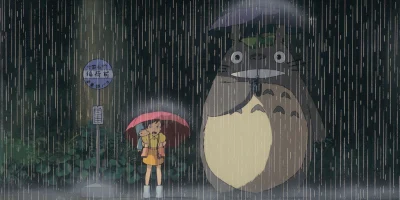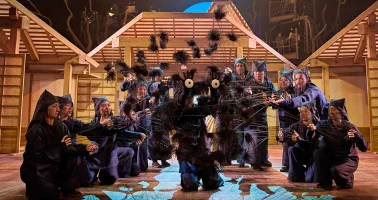
Basil Twist on the magic of puppet storytelling in 'My Neighbour Totoro'
The puppet designer and director shares how he, along with a global team, made the beloved Studio Ghibli characters a reality, in the Olivier-winning play.
"The main thing I do is be a cheerleader for the puppets and the performers — when they come alive, it’s thrilling, and I want to let people know that,” shared Basil Twist, the My Neighbour Totoro puppet designer and director.
Twist isn’t the show’s only cheerleader, though. Following unanimous praise that the Studio Ghibli stage adaptation epitomises theatre magic, and six Olivier Award wins, including Best Comedy or Entertainment Play, we're all cheering for the play of the moment.
The My Neighbour Totoro play remains faithful to the 1988 film: two sisters, Satsuki and Mei, discover a world of unbelievable adventures as they find magical creatures on their doorstep. However, it’s the puppets that take centre stage in this retelling. So, ensuring that Totoro looked right was crucial to the show’s success.
“He’s such a beautiful character, so it was ultimately inspiring, but it was a lot of responsibility to stick to something so beloved and iconic,” said Twist, as he reflected on how the title character took shape. And the people voted with their feet; My Neighbour Totoro broke Barbican box office records, with two sold-out runs, and now it's heading to the West End.
But how did Twist make My Neighbour Totoro a reality? We spoke to Basil Twist about the collaborative creative process, designing Totoro, and the future of puppetry in West End theatre.
Book My Neighbour Totoro tickets on London Theatre.
When did you join My Neighbour Totoro?
Phelim McDermott and Tom Pye introduced me to the project towards the end of 2019. I was working with McDermott (director) and Pye (set designer) on a production of Aida at the English National Opera, and they told me about this project, Totoro, and said, “We think we need you.”
What attracted you to the play?
I loved working with Phelim and Tom already, but I was especially attracted by the obvious possibility of puppetry in this show — the necessity of puppetry in this show —as well as, of course, the My Neighbour Totoro property, this iconic film by Hayao Miyazaki, that was super attractive. I have great admiration for all his work, and I love all things Japanese, so that was a big pull for me.
What was your creative process for incorporating the puppets into My Neighbour Totoro?
It was clear right away from the script and the film, what needed to be puppets — those fantastical elements, starting with the soot sprites and then the other magical creatures — Totoro, his friends, and the Catbus — these needed to be solved by puppetry. Then there were other opportunities: the chickens, the goat, the corn, and even how the house is animated. They all become an opportunity to approach things from a puppetry point of view.
The first thing was Totoro and his friends. Early on with Phelim and Tom, we had an initial workshop amongst the three of us where we talked things through — the set needed to accommodate the puppets because they were so significant in the story.
We had two major workshops during the pandemic on the stage of the Barbican, which also involved performers — some of whom then became a part of the show — including Mei Mac.
These workshops were key for everyone, especially for Phelim and Tom, to understand how [the puppets] would work, how much the puppeteers would be visible, how much an extraordinary performer like Mei, just in relating to a puppet, can bring it to life.
Once the puppets were built and we started rehearsals, one of the first things we did was to introduce the cast to the puppets, and it was a moment of outrageous joy. The cast was so excited to meet them; I’ve rarely had an experience like it — it was so joyous.
Every puppet is different, and these puppets were something different to what people, even those with experience, had ever worked with. Everybody participates in the puppetry at some point, it’s about jumping in and being willing and game and excited — which everyone was. The main thing I do is to encourage people, to be a cheerleader, for the puppets and the performers — when they come alive, it’s thrilling, and I want to let people know that.
How did you collaborate with Mervyn Millar’s Significant Object and Jim Henson’s Creature Shop for the puppets?
I started by making prototypes in California and New York, and I then brought those prototypes to London. For our workshops, I worked with Mervyn Millar and his team (Significant Object) to bring those prototypes to the next level, and to also work on things like the soot sprites or the corn.
Mervyn Millar is a fantastic working partner and has a great team of people. Working with them in those initial workshops was key, and eventually in building those further characters like the soot sprites, the goat, and the chickens.
Jim Henson’s Creature Shop came in later — I brought the prototypes I had made early on and those we made during the workshops to explain the basic concept. I moved to LA to be part of that build process and to supervise it, and it was a joy for me. The Henson’s are the dream puppet company, but they all started from the seeds of ideas I had made from humble prototypes made of cardboard and bed sheets.
How did you approach bringing the character of Totoro to life through puppetry?
The Totoro character is already so beloved and specific; people know his proportions and what he looks like, so I had a really specific roadmap. He has a round shape, so that helped choose our methods to build him.
How Totoro was created was of the utmost importance to our Executive Producer, Joe Hisaishi, and our Japanese partners. They wanted to know how it would be done early on, so, as we were in the middle of the pandemic, I made the prototypes in the garden with my family in California to show them my ideas.
I used my intuition, I get a feel early on about how I think something should be done, and I will make a prototype with my humble materials, and eventually try to keep the final methods as close to that as possible. Those materials have a life force, so I try not to deviate from the simple.
It was also important that the quality of Totoro be that you really want to touch him, that you want to fall asleep on his belly. I work a lot with fabric — in my previous work with Phelim and Tom [Aida at the English National Opera,] I was the ‘silk choreographer,’ I work with fabric because it has a life of its own. All of the puppets have a life within them, a shimmer or a jiggle, it’s inherent to the materials you use. The puppeteers activate that, but the puppet has a life of its own.
Were there any challenges with designing the puppets?
There is always a challenge when moving from a prototype to the real thing, usually always the weight. We shifted techniques along the way to find out what worked, starting with what the Henson’s made, but then also using the resources of the Royal Shakespeare Company’s scenic workshop, working with Alan Bartlett, and Mervyn Millar and Significant Object.
There was also pressure; there is so much love for the film and its characters, so you want to get it right. He’s such a beautiful character, so it was ultimately inspiring, but it was a lot of responsibility to stick to something so beloved and iconic.
How did you retain the charm of the original Studio Ghibli film while choreographing the puppets?
I would refer to the film all the time. I showed the film on my iPad to the performers when rehearsing, but I would also bring up the film to refer to at any moment, to look at any scene, any angle we see the characters — the film was always there. Ultimately, the characters, especially Totoro, gave us a clear map of what to do and how to keep that charm, it’s all in the film.
In recent years, puppetry has formed a key aspect of hit shows: My Neighbour Totoro, Life of Pi, War Horse, etc. Where do you see the role of puppetry heading in the future?
Because of the success of these shows, puppetry has proven itself to be able to bring stories that would otherwise have been considered impossible to stage to life. So, I think we’ll see more stories.
I also think that puppetry provides us with a real experience of magic that we are even more thirsty for in our tech-obsessed lives. I think that not only do we see that puppetry can bring these unstageable stories to life, but that it also feeds our souls in a way we need more than ever.
Book My Neighbour Totoro tickets on London Theatre.
This interview has been condensed and edited for length and clarity.
Frequently asked questions
What is My Neighbour Totoro about?
Don't miss the theatrical event of 2025, the record-breaking, award-winning My Neighbour Totoro is now playing in London's West End.
Where is My Neighbour Totoro playing?
My Neighbour Totoro is playing at Gillian Lynne Theatre. The theatre is located at 166 Drury Lane, London, WC2B 5PW.
How long is My Neighbour Totoro?
The running time of My Neighbour Totoro is 2hr 30min. Incl. 1 interval.
How do you book tickets for My Neighbour Totoro?
Book tickets for My Neighbour Totoro on London Theatre.
What's the age requirement for My Neighbour Totoro?
The recommended age for My Neighbour Totoro is Ages 6+. Children under the age of 4 (including babes in arms) will not be admitted. Children need to occupy their own seat. Under 16s must be accompanied by an adult. All guests, regardless of age, must have a valid ticket..
Who wrote My Neighbour Totoro?
The play, which is written by Tom Morton-Smith, is based on the 1988 Studio Ghibli film of the same name.
Who directed My Neighbour Totoro?
The play is staged by Phelim McDermott, who earned an Olivier Award for his direction of the show at the Barbican.
Is My Neighbour Totoro appropriate for kids?
This imaginative play is best for children ages 6 and up, and those under the age of four will not be permitted in the theatre.
Is My Neighbour Totoro good?
My Neighbour Totoro is a fantastic, award-winning, and record-breaking show. With an imaginative and heartwarming story and exceptional puppetry, this performance is fun for the whole family. The show has also received numerous rave reviews, including London Theatre’s review, which reads, “Tom Morton-Smith’s adaptation strikes a perfect balance of honouring Hayao Miyazaki’s creation and seeking a new theatrical language, brilliantly realised in Phelim McDermott’s exquisite production.”
Originally published on







